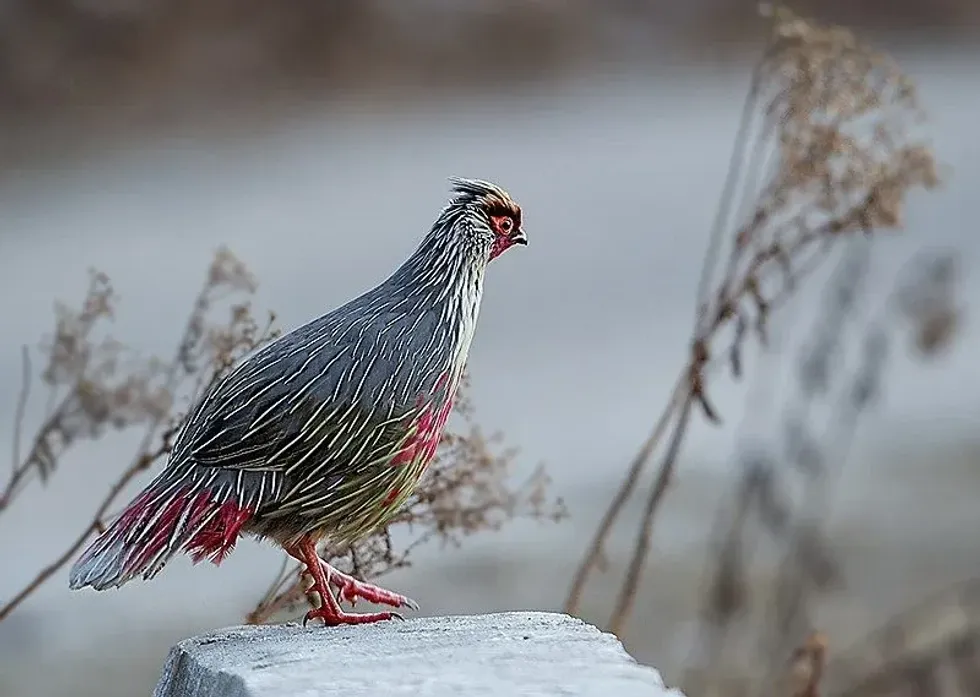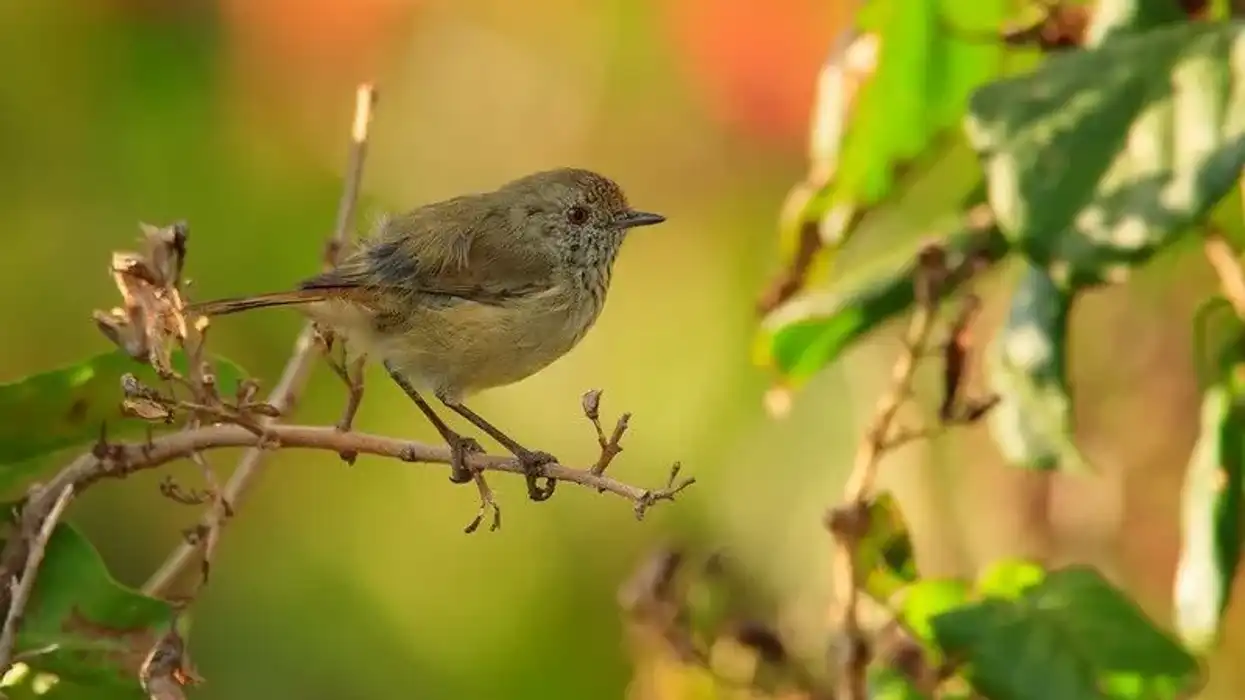The blood pheasant, Ithaginis cruentus as it is scientifically known, belongs to the family Phasianidae and is found in mixed or coniferous forests types of habitat ranging in Nepal, Sikkim, Tibet, the south-central part of China, and in the northern parts of Myanmar and it is found at higher elevations in summer.
The plumage of these species is known to be a dark shade of ash and has white shafts. The coverts of the wings have green streaks and wide or broad lines or outlines on almost every feather.
The bill of these species is short and strong and convex-shaped and is black-colored.
The tail is known to have around twelve sub feathers which tend to be equal in size and has coverts that are dark or deep crimson red-colored.
Female is smaller than male and are known to be more uniformly colored than a male and can be differentiated based on rufous feathers or wings.
Breeding takes place around late April and early May and before breeding males are known to perform courtship displays. The reproduction is monogamous and females build nests using pine needles, twigs.
Six to seven oval, long eggs are laid and these eggs are pinkish or yellowish-white colored with brownish spots.
This species is known to be omnivorous and feeds on beetles, flies, mosses, lichens, and pine shoots.
There have been 12 subspecies of the Blood pheasants recognized and some of the subspecies are named Himalayan blood Pheasant, rock's blood pheasant, Tibetan blood pheasant. Blood pheasant's average lifespan is unknown but they are generally known to live for about two years in the wild.
It is quite interesting to know about the blood pheasant, Ithaginis cruentus as it is scientifically known and if you are interested, read about hawk facts and kea parrot facts too.
Blood Pheasant Interesting Facts
What type of animal is a blood pheasant?
A blood pheasant is a bird.
What class of animal does a blood pheasant belong to?
It belongs to the class Aves.
How many blood pheasants are there in the world?
There has been no exact number of these species estimated or recorded.
Where does a blood pheasant live?
These pheasants can be found in forests ranging in Nepal, Sikkim, Tibet, the south-central part of China, and in the northern parts of Myanmar.
What is a blood pheasant's habitat?
These birds inhabit forest types of habitat like mixed and coniferous forests and scrubs like regions around near snowline. These birds tend to be or are found at higher elevations during the summer season and when the snow increases, these birds migrate or move to lower areas.
Who does blood pheasant live with?
These birds are known to be seen or spotted in groups or flocks until the winter season.
How long does a blood pheasant live?
In general, pheasants are known to have a natural lifespan of one or two years in the wild.
How do they reproduce?
At around one year, these species reach breeding age. The females are known to build the nest and it starts around late April and early May and around this time courtship displays by males start to take place that includes performing high leaps flying breast to breast.
The nest is built by using dry twigs, leaves, tree roots and is surrounded by fir or pine trees. The nest is not deep.
Around six to seven oval, long pinkish-colored eggs with brownish spots are laid by the female.
Incubation takes place for about 27-29 days and is done by the female while the male guards the nest or the eggs. The chicks hatch around mid-June and at about two days, it is known to follow its mother.
What is their conservation status?
The conservation status of this species is of Least Concern according to the IUCN.
Blood Pheasant Fun Facts
What does a blood pheasant look like?

The plumage of these species is known to be a dark shade of ash and has white shafts.
The coverts of the wings have green streaks and wide or broad lines or outlines on almost every feather. The bill of these species is short and strong and convex-shaped and is black-colored.
It is known to be feathered along the line of the eye and the bill.
The chin feathers are crimson colored while that on the belly and breast and sides, the feathers have green tips with crimson borders or margins which looks similar to the dashes of blood spread around on the breast and belly.
The tail of this bird is known to have around 12 sub feathers that tend to be equal in size and have coverts that are dark or deep crimson red-colored. They have red-colored feet and a distinguished eye ring of skin that is also crimson-colored and in some species, it is known to be orange.
The males tend to be larger than females and can be distinguished from females by the red and black color on the throat, neck, tail, and presence or lack of wings that are rufous.
How cute are they?
These pheasants are considered cute because of their colorful plumage.
How do they communicate?
Not much information is available about the communication of these but just like other species, these pheasants are also known to produce or create sounds and calls of varying nature to communicate.
How big is a blood pheasant?
These pheasants are known to be similar in size to a small fowl and smaller than a ring-necked pheasant. The males can be 17-19 in (432-483 mm) long while the females are known to be 6.5-7.1 in (165-180 mm) long.
How fast can a blood pheasant fly?
The exact speed of these pheasants is unknown but they are not very good flyers.
How much does a blood pheasant weigh?
The weight of this bird ranges from 0.90-1.44 lb (0.41-0.655 kg).
What are the male and female names of the species?
There are no specific names for the males and females of the species.
What would you call a baby blood pheasant?
Baby blood pheasants are referred to as chicks, juveniles, or young ones.
What do they eat?
The diet of this bird is omnivorous and they tend to feed on berries, pods, pine seeds, green shoots, butterflies, beetles, snails, and various types of flies.
Are they poisonous?
This bird is not considered poisonous.
Would they make a good pet?
It is very uncommon to see that this bird is kept as a pet as it is restricted to a particular area or region and are wild birds and thus, it is believed that this bird would not make a great pet.
Did you know...
This species is known to be monogamous, unlike the common pheasant.
The shape of this species is known to be similar to that of a chicken.
A female is known to choose her mate based on factors like length of ear tufts, tail, and the black spots or speckles in the wattle.
This species is known to have adapted to hypoxia and ultraviolet radiations of high levels as they are found in high elevations or altitudes in summer.
This species is known to be good runners.
12 subspecies of this bird have been recognized that include Beick's blood pheasant, Himalayan blood pheasant, Clarke's blood pheasant, Rock's blood pheasant, Tibetan blood pheasant, and Mrs. Vernay's blood pheasant.
This species was known to be the national bird of the kingdom of Sikkim and presently is the state bird of Sikkim.
Are they predators?
Yes, this bird is considered to be a predator as it feeds on beetles, butterflies, snails, and other flies.
Are they loud?
These pheasants make loud sounds or calls which could sound as 'jijijiji' or 'glee-glee-keewee' or 'si-si-si.'
Here at Kidadl, we have carefully created lots of interesting family-friendly animal facts for everyone to discover! Learn more about some other birds including magpie facts and cooper's hawk facts.
You can even occupy yourself at home by coloring in one of our free printable blood pheasant coloring pages.









